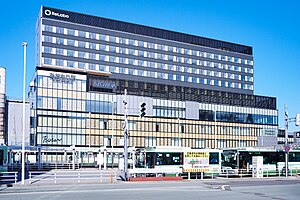|
Aomori Station
Aomori Station (青森駅, Aomori-eki) is a railway station in the city of Aomori in Aomori Prefecture, Japan. The station has been operating since September 1891, though the most recent station building, which consists of three island platforms connected to the station building by a footbridge, was completed in March 2021. Since 1987 the station has been used by the East Japan Railway Company (JR East) which operates various services to destinations throughout the Tōhoku region. Since 2010 the station's operations have been jointly run by JR East and the Aoimori Railway Company, a third sector, regional rail operator. LocationAomori Station is located at the western terminus of Aomori Prefecture Route 16, a 1,169-meter-long (3,835 ft) road that provides access to the station from Japan National Route 4 in central Aomori.[1] The station is situated within the urban core of central Aomori[2] and is in close proximity to the city hall, prefectural hall, the city library, and several landmarks and museums including the Aomori Bay Bridge, A-Factory, and Nebuta Museum Wa Rasse.[3] Aomori Station is the northern terminus of the Ōu Main Line and the Aoimori Railway Line and the southern terminus of the Tsugaru Line. The stations adjacent to it along those lines, respectively, are Shin-Aomori Station, Tsutsui Station, and Aburakawa Station.[4][5] Station layoutAomori Station has three island platforms connected to the station building by a footbridge. The station has a "Midori no Madoguchi" staffed ticket office, a convenience store, and a View Plaza travel agency.[5] The station's two ticket offices for JR East and the Aoimori Railway Company are attended daily from 5:20 am to 10:30 pm, while the View Plaza agency is attended from 10:00 am to 5:30 pm daily.[6][7] Tickets can also be purchased at two separate automatic dispensers for JR East and the Aoimori Railway Company.[5] A second footbridge added during the station's reconfiguration in March 2021 connects the areas to the east and west of the station, allowing pedestrians to cross over the station's platforms without purchasing a ticket.[8] Platforms
HistoryThe station opened on 1 September 1891 as the northern terminus of the Ueno–Aomori line of the Nippon Railway.[9] It became a station on the Tōhoku Main Line of the Japanese Government Railways (JGR), the pre-war predecessor to the Japan National Railways (JNR), after the nationalization of the Nippon Railway on 1 November 1906.[10] The station and its adjacent port facilities were destroyed during strategic bombing of Aomori in World War II on 28 July 1945. Kominato Station in Hiranai picked up the destroyed station's role as the terminal station of the Tōhoku Main Line until the reconstruction of Aomori Station was completed on 15 July 1949.[11] The temporary structure built after the war was replaced in 1959 with the station building that was used until March 2021.[12]  With the privatization of Japanese National Railways (JNR) on 1 April 1987, the station came under the control of JR East.[9] On 4 December 2010, the Tōhoku Shinkansen was successfully extended north to Shin-Aomori Station from Hachinohe.[13] As a result of the opening of the bullet train between the two stations, that section of the Tōhoku Main Line including the line's platforms at Aomori Station was transferred to the Aoimori Railway Company from JR East on the same day.[14] In October 2018 construction commenced on the fifth iteration of the Aomori Station building with improved access to the station's western entrance.[15] On 27 March 2021, the fourth-generation station building was closed following the opening of the fifth-generation station building and the conclusion of celebratory festivities in the older building.[16] Following the movement of station operations, the area occupied by the older building is slated to be replaced with commercial space operated by the city of Aomori and JR East as well as a hotel that overlooks the station platforms. The multi-use, ten-story building is set to be complete in 2024.[17] Services Aomori Station is served by the Ōu Main Line and the Tsugaru Line of JR East. It is also served by the regional Aoimori Railway Line. The Tsugaru-Kaikyō Line formerly served Aomori Station as a connection to Hakodate in Hokkaido via the Seikan Tunnel; however, with the opening of the Hokkaido Shinkansen, conventional rail passenger services between Aomori and Hakodate have since been discontinued. Aoimori Railway servicesAomori Station is primarily served by trains operating on a local service on the Aoimori Railway Line between it and Hachinohe Station; however, the station is also served by one rapid express train on the line, the 560M train operated jointly by the Aoimori Railway and the Iwate Galaxy Railway between Aomori and Morioka. Passenger trains serve Aomori Station just over 18 hours a day from 5:41 am to 11:54 pm. At peak hours between the first train and 9:39 am, trains depart from the station roughly every 30 minutes; otherwise trains depart at an hourly basis.[18] Limited express train servicesThe following limited express services stop at Aomori Station:
Former servicesThe following Limited express services used to stop at Aomori Station:
The following overnight sleeping car services also used to operate to and from Aomori Station. Bus services Buses serving the station are operated by the following operators. Highway buses
Passenger statisticsIn fiscal 2016, the JR East portion of the station was used by an average of 5,342 passengers daily (boarding passengers only).[26] In popular cultureAomori Station is the setting for the 1977 enka song by Sayuri Ishikawa "Tsugaru Kaikyō Fuyugeshiki". The song is about a young woman who has left a lover behind in Tokyo and is thinking back on them as she disembarks from a train at the station and prepares to board a ferry boat to Hokkaido.[27] See alsoReferences
External linksWikimedia Commons has media related to Aomori Station.
|
||||||||||||||||||||||||||||||||||||||||||||||||||||||||||||||||||||||||||||||||||||||||


